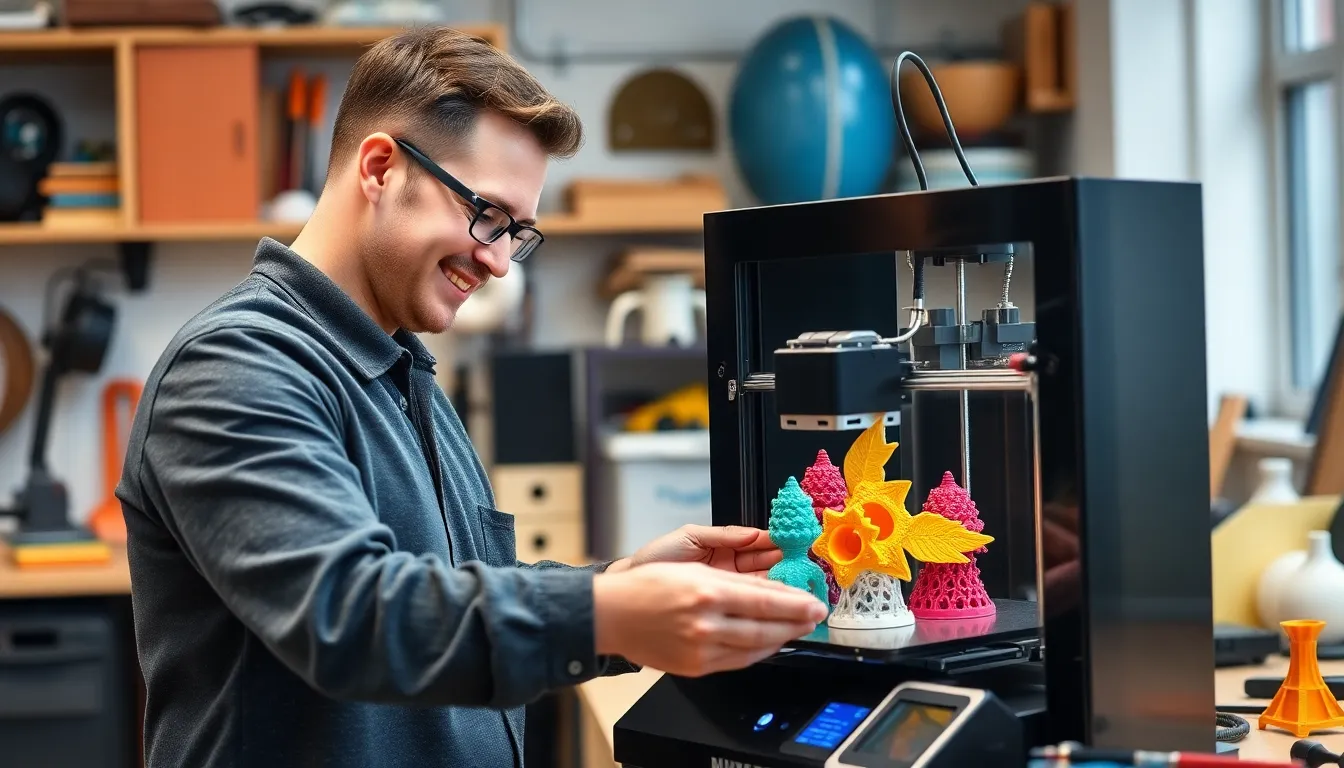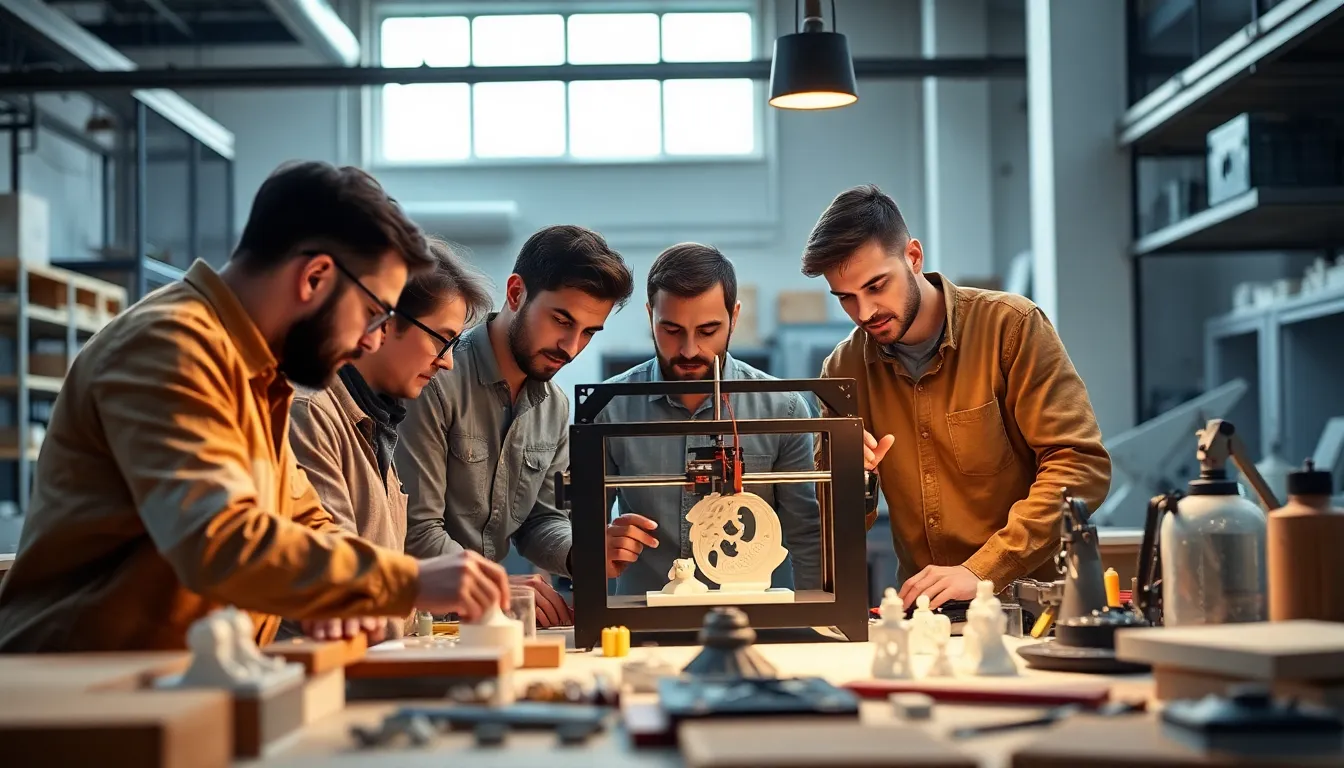Imagine a world where 3D printing isn’t just about flat surfaces and basic shapes. Enter non-planar 3D printing, the superhero of the additive manufacturing universe. It takes creativity to new heights, transforming the mundane into the extraordinary. With non-planar techniques, designers can break free from traditional constraints and create complex geometries that were once thought impossible.
This innovative approach isn’t just for tech wizards and engineering gurus; it’s for anyone with a wild imagination and a desire to push boundaries. Whether it’s crafting intricate sculptures or developing functional prototypes, non-planar 3D printing opens a treasure chest of possibilities. So buckle up and get ready to explore how this game-changing technology is reshaping industries and revolutionizing the way we think about design. Who knew the future could be so wonderfully weird?
Table of Contents
ToggleOverview of Non Planar 3D Printing
Non-planar 3D printing represents a significant advancement in additive manufacturing. This technique allows the production of geometries that go beyond traditional flat surfaces. Complex shapes and intricate details are achievable through non-planar methods, enabling both artistic and functional designs.
Several techniques enhance non-planar 3D printing. Continuous printing, for example, involves adjusting the nozzle position dynamically, which provides greater design flexibility. Layered printing techniques utilize varying layer orientations, optimizing strength and appearance in finished products.
Materials used in non-planar printing include various thermoplastics and composites. These materials often exhibit superior mechanical properties, making them suitable for demanding applications. By leveraging advanced materials, designers can create parts that offer enhanced durability and performance.
Cost-effectiveness emerges as a critical factor in the wider adoption of non-planar 3D printing. This innovation minimizes material waste through optimized printing paths and reduced support structures. As industries seek ways to reduce production costs, non-planar techniques become increasingly appealing.
Many industries are beginning to embrace non-planar 3D printing. Aerospace, automotive, and architecture sectors particularly benefit from the design freedom it offers. By incorporating this technology, companies can innovate faster and introduce more efficient manufacturing processes.
Explorations into non-planar 3D printing continue to expand. Research into new methods and technologies drives innovation, promising even more possibilities in the future. As the landscape evolves, it invites both amateur and professional creators to engage with this transformative manufacturing approach.
Benefits of Non Planar 3D Printing

Non-planar 3D printing offers significant advantages that enhance traditional additive manufacturing techniques. With its ability to create complex geometries, this method transforms the capabilities of design and production.
Enhanced Design Flexibility
Design flexibility emerges as a primary benefit of non-planar 3D printing. Creative professionals can construct intricate shapes that would be challenging or impossible to achieve with standard flat printing methods. Unique designs arise from the ability to manipulate layers, allowing for customized products tailored to specific needs. Importantly, the freedom to iterate on designs expedites the evolution of prototypes, which enhances innovation. Each layer can conform to specified contours, improving form and function. This innovative approach encourages exploring artistic expression alongside functional engineering.
Improved Material Efficiency
Material efficiency illustrates another critical advantage of non-planar 3D printing. This technique optimizes the use of filaments, reducing waste significantly compared to traditional methods. By minimizing excess material, production costs decrease, making it a more economical choice. Efficient material usage also translates into lighter-weight products, which is essential for industries where weight impacts performance, such as aerospace and automotive. These benefits demonstrate how non-planar printing not only conserves resources but also supports sustainable manufacturing practices, aligning with global trends towards eco-friendly production.
Applications of Non Planar 3D Printing
Non-planar 3D printing finds applications across various industries, showcasing its versatility and potential for innovation. This technology transforms traditional manufacturing paradigms, leading to new possibilities in complex design.
Aerospace Industry
Aerospace companies leverage non-planar 3D printing to create lightweight components that enhance aircraft performance. These components exhibit superior strength-to-weight ratios, reducing material costs and improving fuel efficiency. Additionally, manufacturers can produce intricate geometries which were previously impossible, leading to more aerodynamic designs. Non-planar techniques enable rapid prototyping, allowing for faster testing and iteration of parts. As a result, the aerospace sector benefits from more efficient production processes and improved overall design capabilities.
Medical Sector
In the medical sector, non-planar 3D printing allows for the customization of implants and prosthetics tailored to individual patient anatomy. This specialized printing enables the creation of complex structures that mimic natural bone or tissue, enhancing patient comfort and integration. Surgeons utilize prototypes made via non-planar methods for operation planning, improving outcomes during procedures. Additionally, research continues on biocompatible materials to expand applications in drug delivery and regenerative medicine. Non-planar printing’s precision and adaptability make it a game-changer for personalized medical solutions.
Techniques in Non Planar 3D Printing
Non-planar 3D printing encompasses various techniques that significantly enhance efficiency and design capabilities. This section covers notable methods such as layerless printing and innovative approaches to managing boundaries and supports.
Layerless Printing Methods
Layerless printing methods eliminate traditional layering strategies, allowing continuous material deposition instead. This technique results in smoother surfaces and improved mechanical properties. By using algorithms that determine optimal material flow, users can produce intricate shapes without the constraints of discrete layers. Such methods reduce printing time, enhancing productivity, and enabling faster production of complex geometries.
Boundaries and Supports
Innovations in managing boundaries and supports transform the non-planar printing landscape. These advancements allow for the strategic placement of supports only where necessary, minimizing material waste. Techniques such as self-supporting structures and dynamic support generation adapt to the printed design, maintaining stability during the process. Users benefit from reduced post-processing efforts and improved overall surface quality, ensuring that complex designs remain achievable and cost-effective.
Challenges in Non Planar 3D Printing
Non-planar 3D printing presents several challenges that must be addressed for optimal implementation. These challenges include technical limitations and material compatibility issues that impact performance.
Technical Limitations
Accuracy often becomes a concern in non-planar 3D printing. The complex geometries require precise control over the printing process. Certain machines may struggle with maintaining the correct orientation of components. Additionally, software limitations can hinder the modeling of intricate shapes, leading to longer design cycles. Complexity in the slicing process can result in longer print times, as advanced algorithms are needed to handle the unique demands of non-planar designs. Adjustments in printing speed may be necessary during operation to achieve desired results.
Material Compatibility
Material selection plays a crucial role in the success of non-planar 3D printing. Not all materials exhibit the flexibility required for complex geometries. Many thermoplastics, while widely used, may not adapt well to non-planar techniques, leading to challenges in achieving desired mechanical properties. Composites often offer improved characteristics, but their compatibility with existing printers varies significantly. Adhesion between layers becomes critical, especially in non-planar applications where angles and curves challenge traditional bonding methods. Identifying materials that offer both flexibility and strength is essential for ensuring successful outcomes.
Non-planar 3D printing stands at the forefront of innovation in additive manufacturing. Its ability to create intricate geometries and customized solutions opens new avenues for creativity and efficiency. As industries increasingly adopt this technology the potential for enhanced design flexibility and material efficiency becomes clearer.
The ongoing advancements and research into non-planar techniques promise to overcome existing challenges. This evolution will likely lead to even more applications across diverse fields. Embracing non-planar 3D printing not only fosters innovation but also supports sustainable practices in manufacturing. The future of design and production is undoubtedly being reshaped by this remarkable technology.

